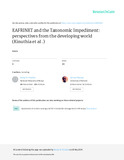| dc.description.abstract | Taxonomic capacity in the developing world is seriously lacking, and as such species identification for both pests and useful species is seriously hampered. Some of these species are key indicators of environmental health and climatic changes, and as such call for continuous and informed monitoring. From the developing world point of view, several useful indicators can be listed for lifecycle assessment. However, such would be limited to taxa that have experts and have been researched on and documented in the region. Such indicators as spiders (Araneae), terrestrial molluscs (Mollusca), bees (Apidae) and beetles (Coleoptera) and their value as indicators are discussed. Measurements of environmental damage and resultant loss of biodiversity, both at the species level (micro) and at the landscape level (macro) as a key baseline for decision making in environmental planning and management form part of the taxonomic mandate. One component of the life cycle assessment, beyond the biodiversity and ecosystem health analysis, therefore must address landscape level impacts. From a developing world perspective, this must involve evolving a toolkit for assessing the economic values of biodiversity and land use impact, including human health and food security. Species stockdynamics, such as availability, ranking and user-preferences, and human/scientific perspectives should form a critical part of the assessment, and within the taxonomic networks this is measured by availability and subsequent access to information and data that is useful and relevant in both space and time. Intra-institutional issues that may contribute to this impediments, and which can be transformed into opportunities to supplement and indeed, bulwark the assessment will be addressed in this paper. | en_US |

